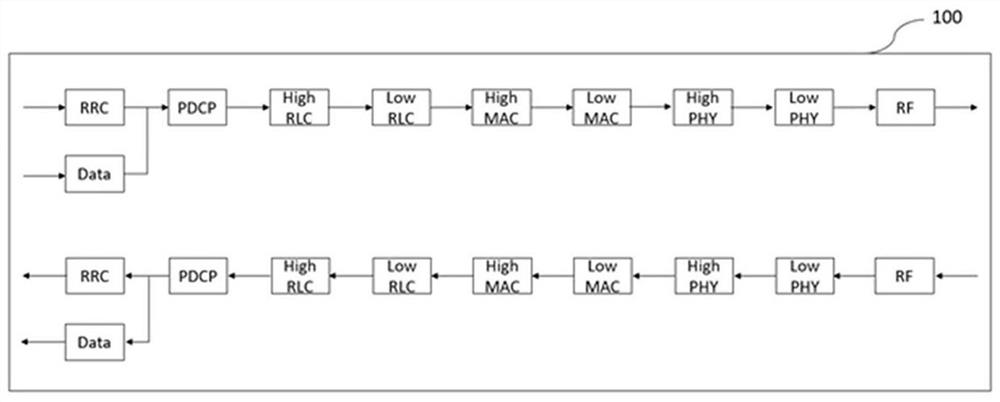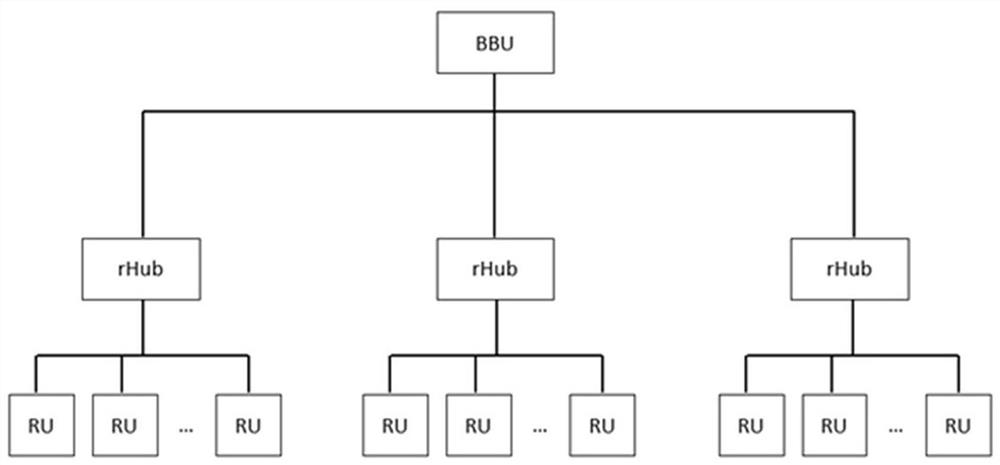Random access signal processing method and device, random access method and device and storage medium
A technology of random access signal and processing method, applied in the field of communication, can solve the problem of low random access success rate, etc., and achieve the effect of improving the random access success rate and avoiding the conflict of time-frequency resources
- Summary
- Abstract
- Description
- Claims
- Application Information
AI Technical Summary
Problems solved by technology
Method used
Image
Examples
Embodiment 1
[0079]In a distributed base station system, UE1 and UE2 select the same preamble ID, and use the same time-frequency resource to send Msg1 to initiate a random access procedure. UE1 is served by RU1, and UE2 is served by RU2. BBU / DU will obtain two Msg1 sent by RU1 and RU2 respectively, and Msg1 contains the same preamble ID. Since the BBU / DU has acquired two Msg1s, it will send two different Msg2s to RU1 and RU2. For Msg2 sent to RU1, the PDCCH (first type channel) carrying DCI1 (first part) is scrambled by the RA-RNTI in step 1, and the DCI1 (first part) contains the indication PDSCH (second type Channel) physical resource information, time-frequency resource position in the response message (Msg2) sent by BBU / DU, MCS required for decoding PDSCH, and RU_ID1; for Msg2 sent to RU2, DCI2 (first part ) PDCCH (first type channel) is scrambled by RA-RNTI in step 1, and the DCI2 (first part) contains physical resource information indicating PDSCH (second type channel), used to in...
Embodiment 2
[0104]In a distributed base station system, the BBU / DU indicates K=3 through RRC signaling, that is, UE1 and UE2 perform Msg2 detection three times at most. UE1 and UE2 select the same preamble ID, and use the same time-frequency resource to send Msg1 to initiate a random access procedure. UE1 is served by RU1 and is located in the center area of RU1, and UE2 is served by RU2 and is located in the edge area of RU2. BBU / DU will obtain two Msg1 sent by RU1 and RU2 respectively, and Msg1 contains the same preamble ID. Since the BBU / DU has acquired two Msg1s, it will send two different Msg2s to RU1 and RU2 respectively. For Msg2 sent to RU1, the PDCCH (first type channel) carrying DCI1 (first part) is scrambled by the RA-RNTI in step 1, and the DCI1 (first part) contains the indication PDSCH (second type Channel) physical resource information, time-frequency resource position in the response message (Msg2) sent by BBU / DU, MCS required for decoding PDSCH, and RU_ID1; for Msg2...
Embodiment 3
[0107] In a distributed base station system, the BBU / DU indicates K=3 through RRC signaling, that is, UE1 and UE2 perform Msg2 detection three times at most. UE1 and UE2 select the same preamble ID, and use the same time-frequency resource to send Msg1 to initiate a random access procedure. UE1 is served by RU1 and is located in the center area of RU1, and UE2 is served by RU2 and is located in the edge area of RU2. BBU / DU will obtain two Msg1 sent by RU1 and RU2 respectively, and Msg1 contains the same preamble ID. Since the BBU / DU has acquired two Msg1s, it will send two different Msg2s to RU1 and RU2. For Msg2 sent to RU1, the PDCCH (first type channel) carrying DCI1 (first part) is scrambled by the RA-RNTI in step 1, and the DCI1 (first part) contains the indication PDSCH (second type Channel) physical resource information, time-frequency resource position in the response message (Msg2) sent by BBU / DU, MCS required for decoding PDSCH, and RU_ID1; for Msg2 sent to RU2...
PUM
 Login to View More
Login to View More Abstract
Description
Claims
Application Information
 Login to View More
Login to View More - R&D
- Intellectual Property
- Life Sciences
- Materials
- Tech Scout
- Unparalleled Data Quality
- Higher Quality Content
- 60% Fewer Hallucinations
Browse by: Latest US Patents, China's latest patents, Technical Efficacy Thesaurus, Application Domain, Technology Topic, Popular Technical Reports.
© 2025 PatSnap. All rights reserved.Legal|Privacy policy|Modern Slavery Act Transparency Statement|Sitemap|About US| Contact US: help@patsnap.com



